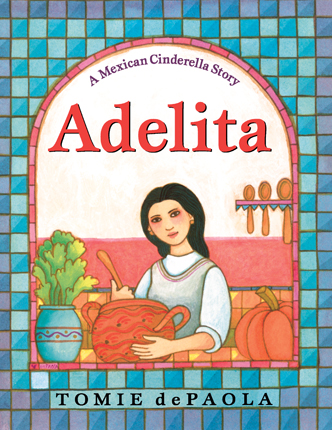Full Text Reviews: Bulletin for the Center... - 12/01/2002 Adelita, beloved charge of her nurse, Esperanza, is bereft when her loving father dies suddenly, leaving her in the care of her coldhearted stepmother. The stepmother fires Esperanza and orders Adelita to the kitchen, where she does all the work and suffers abuse from her mean stepsisters. The inevitable invitation comes, and with the help of Esperanza and a trunk of her deceased mother’s clothes Adelita makes a stunning entrance at the fiesta. There she captures the heart of the host’s son, and true love conquers all. Despite the folkloric-sounding title, this is an original story based on “Cinderella” motifs. The sentences are often short and choppy, but the tale is sprinkled with Spanish phrases explained within the text (a glossary is also included) that add fluidity to the storytelling. The acrylic paintings feature a romantically idealized Mexico of archways and terraces rendered in celebratory shades of violet, pink, yellow, and blue; perusal of the images reveals iconographic images of Catholicism, examples of traditional foods, and even a visit by Frida Kahlo. dePaola’s sometimes flat illustrative style suits his text well here. His characters’ faces are more emotionally revealing than usual: his dark-haired and doe-eyed Adelita, genuinely sweet instead of moony, is especially affecting. Cinderella is a remarkably popular tale; this will be, too. - Copyright 2002 The Board of Trustees of the University of Illinois. School Library Journal - 09/01/2002 K-Gr 3-In this folktale variant, lovely Adelita gains a family when her father remarries. Following the traditional story line, Dona Micaela and her daughters, Valentina and Dulce, are utterly impossible, but all is well as long as Adelita's father is alive. However, when he dies, she is relegated to helping in the kitchen. Eventually, Dona Micaela evicts old Esperanza, and her stepdaughter is left to do all the work. On the night of the fiesta at the Gordillos' hacienda, it is Esperanza who takes the fairy godmother role, sends Adelita to the party, and sees to it that young Javier is smitten. True to form, he locates the young woman when she flees, and they marry. The prose is straightforward and crisp, though the habit of including a Spanish phrase that is translated immediately afterward (e.g., "Soy yo-only me-" or "-mi pequenita-my little one-") interrupts the narrative flow. However, this is a minor quibble given the beauty of dePaola's signature artwork. Making perfect use of clear, warm hues, the full-color acrylic illustrations are a feast for the eye. Depth and brilliance in composition combine with economy of line and form to create a true tour de force. Use this with either Robert D. San Souci's Little Gold Star (HarperCollins, 2000) or Joe Hayes's Little Gold Star/Estrellita de oro (Cinco Puntos, 2000) for different looks at "Cinderella" through Mexican eyes.-Ann Welton, Grant Elementary School, Tacoma, WA Copyright 2002 Cahners Business Information. - Copyright 2002 Publishers Weekly, Library Journal and/or School Library Journal used with permission. Booklist - 08/01/2002 The Cinderella story gets a new setting in this original fairy tale. DePaola uses all the familiar elements but removes much of the magic, giving this version a realistic patina that in no way diminishes listening enjoyment. Children will recognize Adelita's story: her father's remarriage and death; the cruelty of her stepmother and stepsisters; the longing to go to a ball, and her disappearance from the party. But here, her fairy godmother is a loyal family retainer; the prince is a childhood friend; and Adelita is recognized through her own efforts, not with a glass slipper. It's a bit disconcerting that the story's characters seem to know of the Cinderella story (Adelita' stepmother mocks the glass slipper), and the insertion of Spanish phrases into the text immediately followed by the English translation is clunky at times. But the text also has a fresh flair that is matched by the bright, airy artwork, in which shades of peach, teal, and lemon predominate. Mexican tiles frame the action and provide impressive borders for the lovely Adelita. Pair with Domitila (2000) by Jewell Reinhart Coburn, another Cinderella from the Mexican tradition. A glossary of phrases with pronunciations is a boon for tellers. - Copyright 2002 Booklist. Loading...
|



